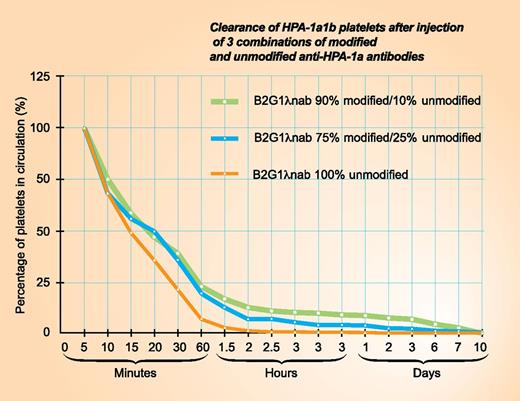In this issue of Blood, Ghevaert et al propose to develop a therapeutic antibody for fetal and neonatal alloimmune thrombocytopenia (FNAIT) that would block the actual antibody in sensitized mothers from binding and therefore prevent, or at least ameliorate, fetal and neonatal thrombocytopenia in fetuses who would otherwise be affected.1 The goal of the group is to engineer an antibody reagent that would on the one hand not engage conventional activating Fc receptors and on the other hand interact normally with FcRn, allowing transplacental passage.
Effect on clearance of radiolabeled sensitized platelets according to the percentage of injected unmodified and modified anti–HPA-1a antibody. Professional illustration provided by Paulette Dennis.
Effect on clearance of radiolabeled sensitized platelets according to the percentage of injected unmodified and modified anti–HPA-1a antibody. Professional illustration provided by Paulette Dennis.
What is the overall problem being dealt with here? It is recognized that FNAIT is caused by a mother becoming sensitized to a platelet antigen expressed on fetal platelets inherited from the father.2 The immunoglobulin G antibodies she produces against this incompatible antigen will cross the placenta and create fetal problems (thrombocytopenia). It is also known that a subsequent affected fetus of the same mother will almost always be more severely affected than the previous fetus.3 Screening for mothers at risk for such sensitization, similar to that used to detect Rh-negative women who are at risk for having fetuses affected with hemolytic disease of the fetus and newborn, has been instituted previously in Norway and other countries as a trial.4 Other than in such a screening program, detection of affected fetuses is almost always via identification of a newborn who is thrombocytopenic and discovering that it is due to FNAIT from a serological workup.5 The first baby affected in a family may suffer an intracranial hemorrhage; if so, the second infant would be at very high risk of also having this serious complication of FNAIT.6
What is the current approach to this situation (ie, a second affected pregnancy with FNAIT)? The current approach is to treat the mother with high-dose intravenous immunoglobulin with or without prednisone to try to decrease the impact of the antiplatelet antibody on fetal platelets. If the treatment is stratified according to the severity of FNAIT in the previous fetus, then this seems to work very well but it does require considerable treatment, which over the course of a pregnancy could be quite expensive.7
Ghevaert et al started work years ago on an anti–fetal human platelet antigen-1a (HPA-1a) antibody that they have modified by changing the Fc portion so that it will not mediate platelet destruction. Even though the antibody will bind to platelets, it will not engage FcγRI, FcγRIIa, or FcγRIIIa. Therefore, platelets sensitized with this modified anti–HPA-1a antibody are not cleared and destroyed. Previous studies in vitro and in animals have shown that the modified antibody can effectively block FcγR binding and platelet clearance by other antibodies, including the unmodified antibody from which it is derived. In addition, they have shown that the antibody interacts normally with FcRn so that it can be transported across the placenta.
In this paper, the investigators report for the first time the use of the modified antibody in human studies. Using dual-radiolabeled platelet survival techniques in normal volunteers, they show that autologous HPA-1a/b platelets coated with the modified anti–HPA-1a blocking antibody have a near-normal in vivo survival (188 hours) and contrast this with survival of platelets coated with the unmodified anti–HPA-1a antibody, which is dramatically shortened (2 hours). Simulating what would occur in therapeutic use for FNAIT, they also show that sensitizing autologous platelets with both antibodies prolongs platelet survival over that achieved using the unmodified anti–HPA-1a antibody alone. The selected portion of the figure from the article by Ghevaert et al dealing with this last point shows that there appears to be a small effect on the clearance of labeled platelets resulting in the slowing of destruction of antibody coated platelets when there is a 3:1 and 9:1 mixture of their modified antibody to the active antibody from which it was derived. The authors appropriately point out that this is not a dramatic effect and may or may not be sufficient to be useful clinically. If the glass is half full, then the effect will be enough to increase the fetal platelet count. If the glass is half empty, then the effect will be insufficient to prevent in utero complications from thrombocytopenia (ie, intracranial hemorrhage). Even if the effect is sufficient, as would be hoped, this study does not address what dose of modified antibody would have to be given or how often to achieve this effect. Unfortunately, it may not be possible to be sure of this strategy’s clinical usefulness until the modified antibody is tested in a situation like the one for which it is intended.
Conflict-of-interest disclosure: J.B.B. currently receives clinical research support from Amgen, Cangene, GlaxoSmithKline, Genzyme, IgG of America, Immunomedics, Ligand, Eisai, Shionogi, and Sysmex. J.B.B.’s family owns stock in Amgen and GlaxoSmithKline. J.B.B. has participated in advisory boards for Amgen, GlaxoSmithKline, Ligand, Shionogi, Symphogen, and Eisai. J.G.M. declares no competing financial interests.

